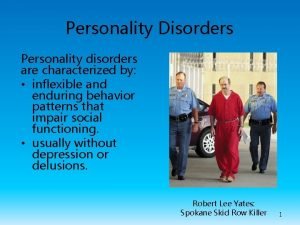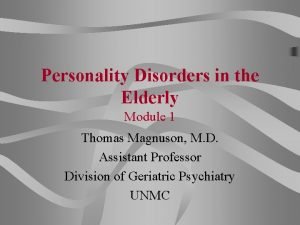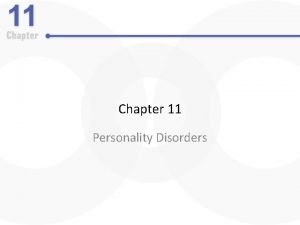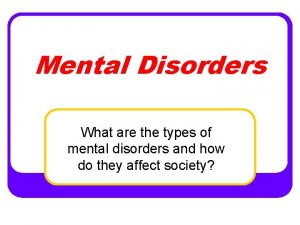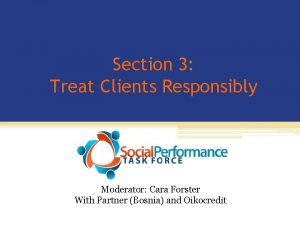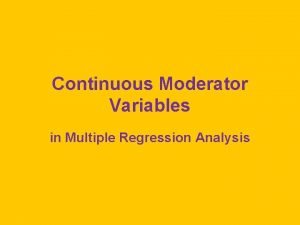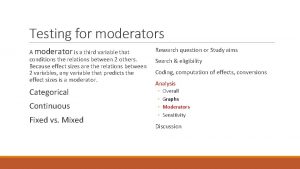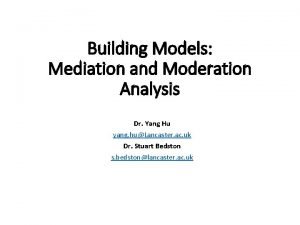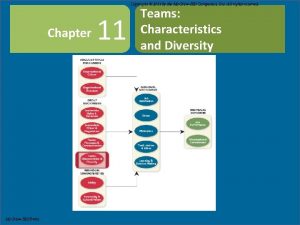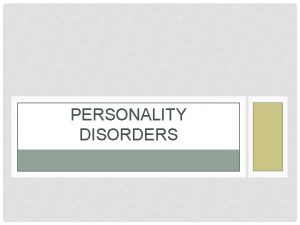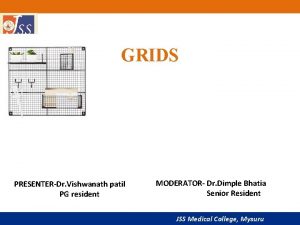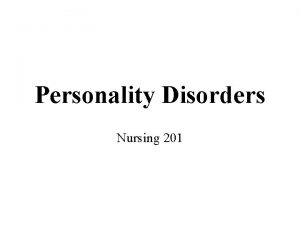PERSONALITY DISORDERS Course Outcome PRESENTERDR AKHILESH M MODERATOR


















































- Slides: 50

PERSONALITY DISORDERS Course & Outcome PRESENTERDR. AKHILESH M MODERATOR- DR. DILSHANA NB

Personality �These are deeply ingrained pattern of behavior that includes modes of perception, relating to and thinking about oneself and the surrounding environment. �It has been widely accepted that personality develops through the interaction of hereditary dispositions and environmental influences.

PD Definition �It is an enduring pattern of inner experience and behavior that deviates markedly from the expectations of the individual’s culture, is pervasive and inflexible, has an onset in adolescence or early childhood, is stable over time and leads to distress or impairment.

Epidemiology �Personality disorders are present in 10 to 20 % of general population � 50% of psychiatric inpatients and out patients. �Etiology For most part, maladaptive personality traits.

Types Cluster B Cluster A • Paranoid • Schizotypal • • Anti social Borderline Histrionic Narcissistic Cluster C • Avoidant • Dependent • Obsessivecompulsive

Treatment �The four stages in the treatment of a patient with PD can be described as (1) crisis management and stabilization (2) awakening of a positive perspective and personal values in life (3) other-centered awareness (4) integrated intelligence

Stabilization �Deals with the presenting problem and stressors �Help the patient get into a calm enough state �Establish a working alliance with the psychiatrist.

Positive Perspective �Involves elevating a person’s outlook on life � Patient can experience things he or she enjoys and values under relaxed conditions.

PD over ages � Separate axis from mental illness from the time of DSM III Rationale- to be considered in comprehensive diagnostic evaluation represented by 5 axis system � DSM III R Rationale – begins in childhood or adolescent and persist in stable form into adult life � DSM IV Consideration to be given for presence of personality disorder that might be overlooked.

Poor data availability Stone MH. Long-Term Outcome in Personality Disorders. British Journal of Psychiatry. Cambridge University Press; 1993; 162(3): 299– 313.

Poor data availability cont… � Long-term studies are fraught with problems affecting validity. � Patterns of illness also shift. � Patients exhibiting severe and socially offensive traits hide these traits from the diagnostician. � Diagnostic criteria change from one generation to another. Stone MH. Long-Term Outcome in Personality Disorders. British Journal of Psychiatry. Cambridge University Press; 1993; 162(3): 299– 313.

The American Psychiatric Publishing Textbook of Psychiatry

Poor data availability cont… � The outcome studies thus far reported have concentrated on personality disorders associated with good reliability and with greatest interest to clinical and forensic specialists. � Both normal and abnormal personality can change trajectory across the lifespan. � Convergent validity was poor between clinical and structured interviews, between interviews and self-report questionnaires, and in between questionnaires. � Clark LA, Livesley WJ, Morey L. Personality disorder assessment: the challenge of construct validity. J Pers Disord 1997; 11: 205– 31.

Poor data availability cont… �The clinical picture of only about half of all individuals with diagnosable personality disorder met criteria for a specific DSM-IV personality disorder. Verheul R, Widiger TA. A meta-analysis of the prevalence and usage of the personality disorder not otherwise specifi ed (PDNOS) diagnosis. J Pers Disord 2004; 18: 309– 19. �Diagnosed with personality disorder not otherwise specified.

Course of PDs �Until the 1980 s, William James’ view of personality, published in 1890, was widely accepted: “By the age of 30, the character has set like plaster, and will never soften again”. �Personality traits become consistent environment genetic effects psychological make-up the goodness of fit

� Personality continues to stabilize until at least age 60 years. Roberts BW, Del. Vecchio WF. The rank-order consistency of personality traits from childhood to old age: a quantitative review of longitudinal studies. Psychol Bull 2000; 126: 3– 25. � No intervention needed for change. � Longitudinal clinical samples show these trends of personality disorder status changing over time without specific intervention. Antisocial and Borderline personality disorder- burnout Odd or avoidant personality disorder tends to increase over time.

Personality stabilize over age

� Individuals with personality disorder tend to change more over time. � Personality disorder in mid-adulthood combination of relatively stable maladaptive traits and acute disturbances. Gutiérrez F, Vall G, Peri JM, et al. Personality disorder features through the life course. J Pers Disord 2012; 26: 763– 74. � General psychosocial functioning in individuals with personality disorder tends to be poor but stable. Skodol AE. Longitudinal course and outcome of personality disorders. Psychiatr Clin North Am 2008; 31: 495– 503.

�The stability of personality in older adults tends to be overestimated. Negative effects of personality disorder in later life account for a high proportion of mortality. cognitive decline in later life. �Those with co-occurring personality disorders generally have poorer outcomes. Stone MH. Long-Term Outcome in Personality Disorders. British Journal of Psychiatry. Cambridge University Press; 1993; 162(3): 299– 313.

�Negative relations also exist for non-suicidal self-injury, substance-use disorders, depressive disorders.

CICS study �The Children in the Community Study longitudinal study of a sample of approximately 800 children Followed periodically for nearly 30 years. �CICS examined the stability of personality disorder traits found that levels decreased by 48% between adolescence (age 14– 16) and early adulthood (age 22) �Greater impairment at mean age 33

�Cluster A traits adolescents with high symptom levels had lower education and achievement, greater partner conflict, and earlier childbearing in early adulthood. High levels of cluster A symptoms during adolescence predicted subsequent violent acts and criminal behavior reduced quality of life at age 33 In cluster A personality disorders, adolescent or young adult symptoms increased risk of subsequent mood, eating, anxiety, and disruptive behavior disorders.

�Cluster B – Adolescents with high levels of cluster B symptoms had lower levels of intimacy and sustained conflict with partners in early adulthood. High levels of cluster B symptoms predicted violent behavior. Quality of life was reduced -Antisocial, borderline, and schizotypal symptoms were independently associated with quality of life reduction. Adolescent or young adult cluster B symptoms increased risk of subsequent mood, anxiety, eating, disruptive, and substance use disorders

�Cluster C Adolescents with high levels of cluster C symptoms had greater conflict with partners. cluster C, adolescent dependent symptoms predicted suicidality. Cluster C personality disorder in early adulthood (age 22) was associated with reduced quality of life at age 33. Cluster C symptoms increased risk of subsequent mood, anxiety, and disruptive behavior

LSPD �The Longitudinal Study of Personality Disorders �Represents a longitudinal study of personality psychopathology in individuals who were not identified patients. �Personality psychopathology decreased by 1. 4 features per year over 4 years

MSAD � The Mc. Lean Study of Adult Development. � The MSAD sample consists of 290 patients with borderline personality disorder who were inpatients and 72 other inpatients who were diagnosed with other personality disorders. � 88% of BPD patients experienced a remission within 10 years. � Psychosocial functioning of borderline patients in the MSAD improved over the first 6 years of follow-up.

�Patients with borderline personality disorder experienced declining rates of many Axis I disorders over 6 years.

PPD � Premorbid traits of PPD social isolation hypersensitivity, hypervigilance, etc � Poor academic performance � Poor adjustment in relationships. � Steady at work – litigious � PPD predicts poorer quality of life, even after controlling for other forms of psychopathology. (Crawford et al. , 2005; Cramer et al, 2007).

SZPD � Socially isolated and withdrawn � Few friends � Relationships tend to fail due to lack of warmth. � Has a poorer quality of life relative to other PDs � Homelessness (Connelly et al, 2008)

STPD �Appear peculiar and odd to their peers during adolescence �Heavily involved in esoteric fantasies and peculiar interests �The symptomatology does not remit with age. �STPD eventually go on to develop schizophrenia, but not all.

Schizotypal � They get rarely admitted to the hospital. � The pure STP patients had outcomes only slightly better than those with frank schizophrenia. � STP patients showed considerable residual impairment. � Only few achieve closeness with their sexual partners. � Suicide rates were less than patients with BPD, mood disorder or Schizophrenia.

ASPD �Conduct disorder is a risk �Unlikely to maintain steady employment �Poor relationships �more likely than the general population to have died prematurely by violent means.

ASPD �Usually have bad prognosis with majority leaving therapy in between. �An early onset of dissocial behavior during childhood is a bad prognostic sign. �A history of antisocial acts before a psychiatric hospital admission were not always indicators of a bad prognosis.

�Several of the males and most of the adolescent females whose antisocial acts had been less serious eventually made good adjustments. �Some simply outgrew their wildness as they reached 30 years of age, settling down into respectable jobs and conventional lives.

BPD � Emotionally unstable, impulsive, and oppositional as children � eating, substance, and mood disorders – adolescence � BPD is a major risk factor for suicide � Relationships tend to be very unstable � Becomes stable by the age of 30 years

BPD � Usually have good prognosis during long term follow up. � Some gets depressed after the age of 40 yrs. � Patients develop substance abuse , but outgrow it. � High suicide rates. Continued alcohol use Chaotic impulsivity History of parental brutality or sexual molestation Concomitant schizotypal features or antisocial features

�Suicides were more common with BPD males with major affective disorders. �Better prognosis with (a) high intelligence (b)unusual talent in music, art, writing, etc (c) unusual attractiveness (d) concomitant obsessive-compulsive traits (e) in the case of alcoholics, adherence to AA.

HPD � During adolescence- attention seeking � will readily form new relationships but will have difficulty sustaining them. � Not reliable or responsible � Erratic employment history. � severity of the symptomatology diminish with age.

NPD �Seemingly well adjusted as young adults. �Relationships will get strained over time. �Occupational success – erratic. �Poor insight – initially

Narcissistic personality disorders �NPD group showed a higher rate of admission at long term follow-up than did the BPD patients �They also had a poorer overall level of function and sexual satisfaction. �Young males with prominent narcissistic features would be particularly prone to suicide.

AVPD � Shy, timid, and anxious as children. � Good at jobs with less public interaction. � Will have difficulty developing relationship. � Responsible, empathic, and affectionate- as parent � Symptomatology diminishes with age. � Prone for substance use.

DPD � Excessively submissive as children and adolescents. � Prone for mood disorders later in life. � Symptoms improve with age. � Need for reassurance- rejection- decreased self worth � May engage in self-harm to discourage the partner from separating from them. � Respond well to therapy.

OCPD � Well behaved childhood. � Excellent at work. � Relationship with wife and children are strained. � Prone for anxiety disorders. � Chances for depression in middle age.

Summary �Cluster A Paranoid - Poor academic performance & adjustment in relationships Schizoid - poorer quality of life relative to other PDs, socially withdrawn and isolated Schizotypal- does not remit with age, quality similar to schizophrenia

�Cluster B Anti social- unlikely to maintain steady employment or relationship, remits by 4 th decade Borderline- eating, substance, and mood disorders; suicidal; stable by 30 years. Histrionic - Erratic employment history, diminish with age Narcissistic- erratic and strained work and relationship, poor insight till middle age, poor outcome

�Cluster C Avoidant – good at jobs, poor relationship, improves with age. Dependent- Prone for mood disorders later in life. ; Symptoms improve with age. Respond well to therapy Obsessive- compulsive- strained relationships, anxiety and depressive disorder risk, poor relationships.

References � DSM 5 � Kaplan and Sadock's Comprehensive Textbook of Psychiatry, 10 E � Tasman, Psychiatry, 4 E � The American Psychiatric Publishing Textbook of Psychiatry � Giles Newton-Howes, Lee Anna Clark, Andrew Chanen, Personality disorder across the life course, The Lancet, Volume 385, Issue 9969, 2015, Pages 727 -734,

� Stone MH. Long-Term Outcome in Personality Disorders. British Journal of Psychiatry. Cambridge University Press; 1993; 162(3): 299– 313. � Clark LA, Livesley WJ, Morey L. Personality disorder assessment: the challenge of construct validity. J Pers Disord 1997; 11: 205– 31. � Verheul R, Widiger TA. A meta-analysis of the prevalence and usage of the personality disorder not otherwise specifi ed (PDNOS) diagnosis. J Pers Disord 2004; 18: 309– 19. � Roberts BW, Del. Vecchio WF. The rank-order consistency of personality traits from childhood to old age: a quantitative review of longitudinal studies. Psychol Bull 2000; 126: 3– 25.

� Gutiérrez F, Vall G, Peri JM, et al. Personality disorder features through the life course. J Pers Disord 2012; 26: 763– 74. � Skodol AE. Longitudinal course and outcome of personality disorders. Psychiatr Clin North Am 2008; 31: 495– 503. � Giles Newton-Howes, Lee Anna Clark, Andrew Chanen, Personality disorder across the life course, The Lancet, Volume 385, Issue 9969, 2015, Pages 727 -734, � Personality Disorders Over Time: Precursors, Course, and Outcome, by Joel Paris, M. D. Arlington, Va. , American Psychiatric Publishing, 2003, 198 pp. ,

Thank you DR AKHILESH. M dr. akhileshm@outlook. com
 Dr akhilesh dubey indore
Dr akhilesh dubey indore Paranoia disorder
Paranoia disorder Different personality disorders
Different personality disorders Cluster b personality disorders
Cluster b personality disorders Inflexible personality
Inflexible personality Carla homulka
Carla homulka Cluster b personality disorder
Cluster b personality disorder Weird wild wacky personality disorders
Weird wild wacky personality disorders Cluster c
Cluster c Cluster b personality disorder
Cluster b personality disorder Avoidant personality traits
Avoidant personality traits Cluster a personality disorders
Cluster a personality disorders Cluster c personality disorders
Cluster c personality disorders Cluster b personality disorder
Cluster b personality disorder Personality disorder clusters mnemonic
Personality disorder clusters mnemonic Personality disorders dsm 5
Personality disorders dsm 5 Nsnhe,f
Nsnhe,f Regulator moderator war
Regulator moderator war Cara moderator
Cara moderator Continuous moderator
Continuous moderator Antonio vivaldi brainly
Antonio vivaldi brainly Eigenschappen focusgroep moderator
Eigenschappen focusgroep moderator Tugas moderator adalah
Tugas moderator adalah Presentation greeting
Presentation greeting Mediating vs moderating variable
Mediating vs moderating variable What is a difference between the speech and the poster
What is a difference between the speech and the poster Presenter cue
Presenter cue Moderator
Moderator Classification of power plant
Classification of power plant Powerhouse mountain intel
Powerhouse mountain intel Moderator examples
Moderator examples Moderator tom
Moderator tom Moderator speaker
Moderator speaker Moderator
Moderator Moderator vs mediator
Moderator vs mediator Constant moderator
Constant moderator Moderator vs mediator
Moderator vs mediator Intervening variable
Intervening variable Chaine parallèle muscle
Chaine parallèle muscle Stretcher bond t junction
Stretcher bond t junction Course number and title
Course number and title Crash course personality
Crash course personality Outcome based massage
Outcome based massage Outcome based accountability
Outcome based accountability Nursing outcomes classification noc
Nursing outcomes classification noc Rapid access clinic london ontario
Rapid access clinic london ontario Veyldf learning and development outcome descriptors
Veyldf learning and development outcome descriptors Outcome interdependence
Outcome interdependence Therapeutic recreation outcome model
Therapeutic recreation outcome model Outcome example
Outcome example Kaitlyn platt
Kaitlyn platt




